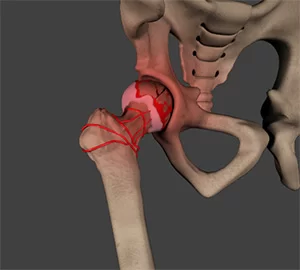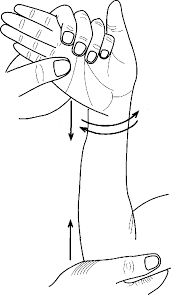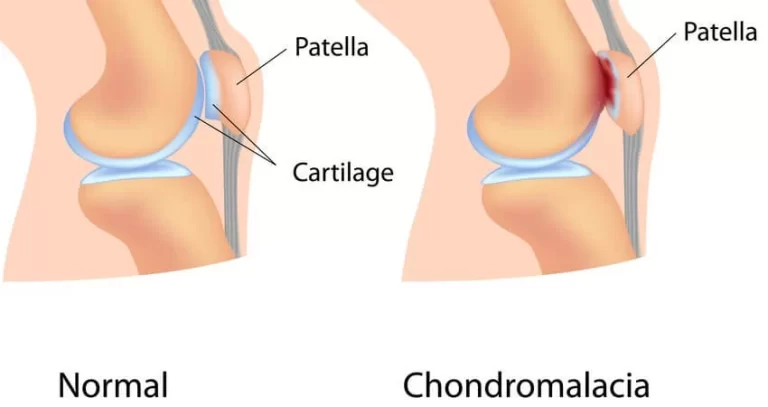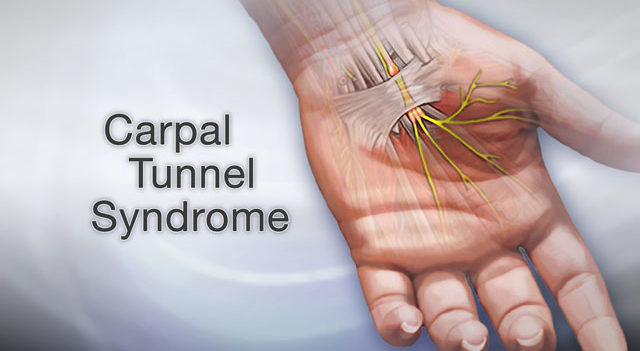Avascular Necrosis (Osteonecrosis)
Avascular necrosis, also known as osteonecrosis, is a condition characterized by the death of bone tissue due to a lack of blood supply.
Avascular necrosis is a painful bone condition that worsens over time and can limit your mobility. It happens when something stops the blood supply to one of your bones. Broken bones, dislocated hips, radiation treatment, and alcohol abuse are among the causes. To reduce pain and increase mobility, the majority of people require surgery, sometimes a joint replacement.
Table of Contents
What is Avascular Necrosis (Osteonecrosis)?
When something prevents blood from getting to your bone tissue, avascular necrosis occurs. As new bone tissue is constantly being produced by your skeletal system to replace old bone tissue that eventually deteriorates and dies, your bones are constantly changing. Consider this process a cycle in which your body produces new tissue to replace old, rotting, and dying tissue. For your bones to remain strong and healthy, this pattern must follow the proper instructions. The oxygen and nutrients that bones require for regrowth and health are carried by the blood. Your skeletal system cannot produce new bone tissue quickly enough without blood flow. The decaying bone starts to break apart and eventually falls.
How common is Avascular Necrosis (Osteonecrosis)?
Every year, between 10,000 and 20,000 Americans experience avascular necrosis. All ages and genders are susceptible, but people in their 30s and 40s are most frequently affected by this condition.
Where does Avascular Necrosis develop?
Any joint can experience avascular necrosis, but the hip is the most common site. The following joints can also experience avascular necrosis:
- Ankles.
- Jaw.
- Knees.
- The upper arm (humerus) and shoulders.
What causes Avascular Necrosis?
Avascular necrosis is brought on by diseases or bone fractures that cut off blood supply to the bone tissue. 20% of cases of avascular necrosis have no apparent cause.
Avascular necrosis has the following known causes:
Traumatic avascular necrosis can develop after a bone or joint is broken.
Non-traumatic avascular necrosis: This develops when a disease or other medical issue prevents blood from reaching your bone tissue. In nontraumatic avascular necrosis, the same bones on both sides of the body are frequently affected. For instance, you are more likely to have avascular necrosis in your left shoulder if you have it in your right shoulder.
Injury to a bone or joint. The blood vessels in the area could be harmed by a wound, such as a dislocated joint.
Bone deterioration and blood vessel damage are side effects of radiation-based cancer treatments—fatty buildup in blood vessel walls. Lipids in fat can obstruct tiny blood vessels. This may lessen the blood flow to the bones.
Specific illnesses. Gaucher’s disease and sickle cell anemia are two illnesses that can reduce blood flow to the bones.
Sometimes the exact cause of avascular necrosis that isn’t caused by trauma isn’t known. A combination of genetics, excessive alcohol use, specific medications, and other illnesses probably contribute.
What bone fractures cause traumatic avascular necrosis?
Some bone fractures are more likely than others to result in avascular necrosis. Bone fractures that frequently result in traumatic avascular necrosis include:
Hip fractures and dislocations: Avascular necrosis occurs in 20% of people who dislocate their hips, meaning that the hip is no longer aligned in the joint as it normally would be.
What diseases or conditions lead to nontraumatic avascular necrosis?
Avascular necrosis can result from a number of medical conditions or treatments, including:
- Osteoporosis. Occasionally, elderly women (and some men) will develop SPONK or spontaneous avascular necrosis of the knee.
- Sickle cell anemia.
- Diabetes.
- Cancer treatments, such as radiation therapy.
- Decompression sickness in scuba divers.
- HIV.
- Lupus.
- Organ transplants.
What types of lifestyle choices put people at risk for Avascular Necrosis?
Several aspects of a person’s way of life raise that risk, including:
Use of alcohol excessively.
Smoking.
Corticosteroid (prednisone) use is prolonged.
What are the symptoms of Avascular Necrosis?
It could take weeks or months before you start experiencing symptoms that could point to avascular necrosis. Following are some signs of avascular necrosis that may manifest gradually:
- Pain comes and goes in waves when you apply pressure to your bone and then release it.
- increasing discomfort and stiff joints.
- restricted range of motion.
- If your knees or hips have avascular necrosis, you may limp.
- Difficulty standing, walking, or climbing stairs.
How is Avascular Necrosis diagnosed?
Your medical professional will evaluate your symptoms and conduct a physical examination.
X-rays are used to look for arthritis symptoms and fractures.
(MRI) Magnetic resonance imaging.
Risk factors
Avascular necrosis can occur as a result of risk factors like:
Trauma. Damage to nearby blood vessels and reduced blood flow to bones can result from injuries like hip dislocation or fracture.
Steroid usage. Avascular necrosis is frequently brought on by using high doses of corticosteroids, such as prednisone. Although the cause is unknown, some experts think corticosteroids may be to blame because they cause blood lipid levels to rise, which would decrease blood flow.
Alcoholism in excess. Additionally, fatty deposits in blood vessels can develop after consuming multiple alcoholic beverages per day for a number of years.
Use of bisphosphonates. Long-term use of bone-density-boosting drugs may increase the risk of developing jaw osteonecrosis. Some patients receiving high doses of these drugs for cancers like multiple myeloma and metastatic breast cancer experienced this uncommon complication.
Specific medical procedures. Cancer radiation therapy may weaken bones. Avascular necrosis is also linked to organ transplants, particularly kidney transplants.
How do healthcare providers treat Avascular Necrosis?
The course of your treatment will depend on how badly your bones have been hurt. If your bone damage is restricted to smaller bones that don’t support weight, you might be able to get one of the
following treatments:
- Rest.
- Cold packs
- Heat Treatment
- Nonsteroidal anti-inflammatory drugs (NSAIDs).
- Physical therapy to improve range of motion and lessen joint pain.
- Canes and crutches are examples of walking aids.
What is the course of treatment for more severe cases of Avascular Necrosis?
Physical Therapy for Osteonecrosis
When osteonecrosis is still in its early stages, physical therapy may be helpful. Physical therapy aims to treat pain, prevent further bone damage, and maintain function. Rehabilitation initiatives could consist of:
- Maintaining range of motion through exercise
- Strengthening Of Muscle around the Hip
- Stretches of the Tight muscles around the Hip
- Pain-relieving Electric Modalities Mainly TENS and IFT
- Extracorporeal Shockwave therapy (ESWT)
Maintaining range of motion through exercise
Motion range Exercise is any activity done to enhance the motion of a particular joint. The arrangement of the bone surfaces within the joint, the joint capsule, as well as the muscles, tendons, and ligaments that act on the joint, all affect this motion.
Strengthening Of Muscle around the Hip
Leg raises will help your hip muscles become stronger. Lay on your right side, using your elbow to raise your upper body. Lift the top leg as high as you can without bending your body or your leg, keeping your right leg flat on the ground. After remaining in place for five seconds, lower your leg.
Stretches of the Tight muscles around the Hip
- Stretching in place
Toes facing forward and feet hip-width apart while standing.
Bring your right heel up towards your butt while bending your right knee. - To point your knee towards the floor, gently pull while holding your right foot in your right hand.
Hold for a minute
Pain-relieving Electric Modalities Mainly TENS and IFT
Both of these pain-relieving procedures make use of electric currents to treat chronic, intractable pain as well as acute, chronic pain that occurs following surgery, trauma, or other traumatic events.
The two procedures were shown to be risk-free and efficient substitutes for pharmacological pain relief. Additionally, they are generally non-addictive and have few side effects for patients. By irritating the skin where the electrodes are positioned, they may result in some undesirable side effects. However, they are both lightweight and convenient to carry.
Extracorporeal Shockwave therapy (ESWT)
In ONFH, extracorporeal shockwave therapy (ESWT) has demonstrated positive results. ESWT reduces hip pain and dysfunction while also causing the ONFH lesion to regress. For patients with early osteonecrosis, cocktail therapy that included HBO, ESWT, and oral alendronate has been shown to be more effective than core decompression with or without bone grafting.
Surgical Treatment
Core decompression: To increase blood flow to the affected bone, your surgeon drills tiny holes (called cores) in the affected bone. To speed up healing, this procedure may be combined with injections or bone grafts.
Joint replacement: A synthetic joint is used to replace your damaged one. In patients with avascular necrosis, hip, and knee replacements are 95% effective in reducing pain and regaining mobility.
Customized exercises are developed by a physical therapist to help the muscles around the injured bone become stronger. To improve blood flow to the area and aid in pain relief, techniques like ultrasound, joint mobilization, and heat may be used. To lessen the pressure on the joint, physical therapists can also help patients if they need help using a cane or walker.
Although osteonecrosis cannot be cured, physical therapy can sometimes help to regain movement, stop the disease’s progression, and lessen any pain that may be associated with it.
Prevention
Avascular necrosis risk reduction and general health improvement
Drink in moderation. One of the main risk factors for developing avascular necrosis is heavy drinking.
Maintain low cholesterol levels. The most frequent substance obstructing blood flow to bones is tiny bits of fat.
Follow steroid usage. Verify that any high-dose steroid use you may be currently or have been using is disclosed to your healthcare provider. The damage that steroids cause seems to get worse with continued use. A result of high-dose steroids is the bone.
Avoid smoking. Blood flow may be lowered because smoking narrows blood vessels.
FAQ
What is the difference between osteonecrosis and Avascular Necrosis?
When something prevents blood from getting to your bone tissue, avascular necrosis occurs. It is also known as osteonecrosis, and it can result in minor fractures and bone collapse.
How long does it take for Avascular Necrosis to develop?
The reason will have a significant impact on how long avascular necrosis takes to develop. For instance, a person must take prednisone or chemotherapy medications for a long time (often over a number of months) in order for those medications to be present in sufficient amounts in their bloodstream to be able to produce avascular necrosis.
The “Hawkins sign” can be utilized as a radiographic marker of the development of avascular necrosis in this location, for example, in the case of talar avascular necrosis, where it can be recognized as early as four to six weeks after the injury if the etiology is related to physical stress.Can you reverse Avascular Necrosis?
While avascular necrosis is not reversible per se, it is feasible to receive treatment to stop the condition’s progression from the early stages to complete tissue death, preserving some function in the damaged joint. The core decompression procedure, which essentially entails drilling into the avascular necrotic lesion to allow blood to reach the area and to prevent worsening of the hypoperfusion of the areas of the femoral head undergoing avascular changes, is traditionally thought to have been beneficial for treating early stages of avascular necrosis of the femoral head.
Other parts of the body can also benefit from therapies of this kind. For instance, retrograde drilling of an avascular necrotic lesion in the talus is a commonly used procedure with different degrees of success.








One Comment